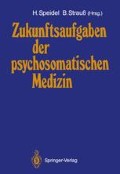Zusammenfassung
In den vergangenen Jahren haben verschiedene Studien die Möglichkeit der operanten Konditionierbarkeit zentralnervöser Vorgänge aufgezeigt. Sowohl im Human- als auch im Tierexperiment ließen sich mit Hilfe operanter Konditionierung bzw. mit Hilfe von Biofeedbackmethoden zentralnervöse Prozesse auf unterschiedlicher neuronaler Ebene modifizieren. So konnte Olds durch operante Verstärkung bei Ratten eine Zunahme der Entladungen tegmentaler Neurone des Mittel- und Zwischenhirns erzeugen (Olds 1965). Fetz und Finocchio (1975) erzielten bei Affen neben anderen neuronalen Einheiten eine Vergrößerung bzw. Verringerung der Entladung von Zellen der Pyramidenbahn.
Diese Arbeit wurde im Rahmen des Sonderforschungsbereichs 307 von der Deutschen Forschungsgemeinschaft (DFG) gefördert (AZ SFB 307/B2).
Access this chapter
Tax calculation will be finalised at checkout
Purchases are for personal use only
Preview
Unable to display preview. Download preview PDF.
Literatur
Beatty J (1977) Learned regulation of alpha and theta frequency activity in the human brain. In: Schwartz G, Beatty J (eds) Biofeedback, theory and research. Academic Press, New York, pp 351–370
Bromm B (1984) Pain-related components in the cerebral potential. Experimental and multivariate statistical approaches. In Bromm B (ed) Pain measurement in man. Neurophysiological correlates of pain. Elsevier, Amsterdam New York Oxford, pp 257–290
Chapman CR, Jacobson RC (1984) Assessment of analgesic states: Can evoked potentials play a role. In: Bromm B (ed) Pain measurement in man. Neurophysiological correlates of pain. Elsevier, Amsterdam New York Oxford, pp 233–255
Chudler EH, Dong WK (1983) The assessment of pain by cerebral evoked potentials. Pain 16: 221–244
Elbert T, Rockstroh B (1984) Classification and overview of CNS electrical activity tested on operant conditioning. In: Elbert T, Rockstroh B, Lutzenberger W, Birbaumer N (eds) Self-regulation of the brain and behavior. Springer, Berlin Heidelberg New York Tokyo, pp 59–63
Fetz EE, Finocchio DV (1975) Correlations between artivitiy of motor cortex cells and arm muscles during operantly conditioned response patterns. Exp Brain Res 23: 217–240
Finley WW (1984) Biofeedback of very early potentials from the brain stem. In: Elbert T, Rockstroh B, Lutzenberger W, Birbaumer N (eds) Self-regulation of the brain and behavior. Springer, Berlin Heidelberg New York Tokyo, pp 143–163
Finley W, Johnson G (1981) Biofeedback of brainstem auditory evoked potentials. (Proceedings of the 12th Annual Meeting of the Biofeedback Society of America, pp 15–18)
Ford M, Bird BL, Newton FA, Sheer D (1980) Maintenance and generalization of 40 Hz EEG biofeedback effects. Biofeedback Self Regul 5: 193–205
Hauri P (1980) Biofeedback techniques in the treatment of chronic insomnia. In: Williams R, Karacan I (eds) Sleep disorders: diagnosis and treatment. Wiley & Sons, New York
Hillyard SA (1984) Event-related potentials and selective attention. In: Donchin E (ed) Cognitive psychology: event-related potentials and the study of cognition. Erlbaum, Hillsdale (The Carmel Conferences, vol 1, pp 51–72)
Kamiya J (1984) On the relationships among subjective experience, behavior, and physiological activity in biofeedback learning. In: Elbert T, Rockstroh B, Lutzenberger B, Birbaumer N (eds) Self-regulation of the brain and behavior. Springer, Berlin Heidelberg New York Tokyo, pp 245–254
Lutzenberger W, Birbaumer N, Wildgruber C (1975) An experiment on the feedback of the theta activity of the human EEG. Eur J Behav Anal Modif 2: 119–126
Miltner W, Larbig W, Braun C (1986) Biofeedback of visual evoked potentials. Int J Neurosci 29: 291–303
Miltner W, Larbig W, Braun C (in press) Tooth pulp and intracutaneous electrical stimulation. Major properties and differences.
Mullholland TB (1984) Concepts of control in biofeedback. In: Elbert T, Rockstroh B, Lutzenberger W, Birbaumer N (eds) Self-regulation of the brain and behavior. Springer, Berlin Heidelberg New York Tokyo, pp 277–295
Näätänen R, Gaillard AWK, Mäntysalo S (1980) Brain potential correlates of voluntary and involuntary attention. In: Kornhuber HH, Deecke L (eds) Motivation, motor, and sensory processes of the brain. Electrical potentials, behavior, and clinical use. Elsevier, Amsterdam New York Oxford, pp 343–348
Olds J (1965) Operant conditioning of single unit responses. Expecta Med 372–380
Rhodes DL, Buffington V, Chapman CR (1987) Effects of attention/distraction on evoked potentials to painful and nonpainful gingival stimulation. Pain 183
Rockstroh B, Elbert T, Birbaumer N, Lutzenberger W (1982) Slow brain potentials and behavior. Urban & Schwarzenberg, München Wien Baltimore
Roger M (1984) Operant control of evoked potentials: Some comments on the learning characteristics in man and on the conditioning of subcortical responses in the curarized rat. In: Elbert T, Rockstroh B, Lutzenberger W, Birbaumer N (eds) Self-regulation of the brain and behavior. Springer, Berlin Heidelberg New York Tokyo, pp 180–197
Rosenfeld JP, Dowman R, Silvia R, Heinricher M (1984) Operant controlled somatosensory brain potentials: Specific effects on pain processes. In: Elbert T, Rockstroh B, Lutzenberger W, Birbaumer N (eds) Self-regulation of the brain and behavior. Springer, Berlin Heidelberg New York Tokyo, pp 164–179
Sheer DE (1975) Biofeedback training of 40 Hz EEG and behavior. In: Barch N, Altschuler HL (eds) Behavior and brain electrical activity. Plenum, New York, pp 325–362
Sheer DE (1984) Focused arousal, 40-Hz EEG, and dysfunction. In: Elbert T, Rockstroh B, Lutzenberger W, Birbaumer N (eds) Self-regulation of the brain and behavior. Springer, Berlin Heidelberg New York Tokyo, pp 64–84
Sterman MB (1984) The role of sensorimotor rhythmic EEG activity in the etiology and treatment of generalized motor seizures. In: Elbert T, Rockstroh B, Lutzenberger W, Birbaumer N (eds) Self-regulation of the brain and behavior. Springer, Berlin Heidelberg New York Tokyo, pp 95–106
Editor information
Editors and Affiliations
Rights and permissions
Copyright information
© 1989 Springer-Verlag Berlin Heidelberg
About this paper
Cite this paper
Miltner, W., Braun, C., Larbig, W., Ammon, K. (1989). Biofeedback ereigniskorrelierter Potentiale verringert experimentell induzierten Schmerz. In: Speidel, H., Strauß, B. (eds) Zukunftsaufgaben der psychosomatischen Medizin. Springer, Berlin, Heidelberg. https://doi.org/10.1007/978-3-642-73842-5_29
Download citation
DOI: https://doi.org/10.1007/978-3-642-73842-5_29
Publisher Name: Springer, Berlin, Heidelberg
Print ISBN: 978-3-540-19448-4
Online ISBN: 978-3-642-73842-5
eBook Packages: Springer Book Archive

